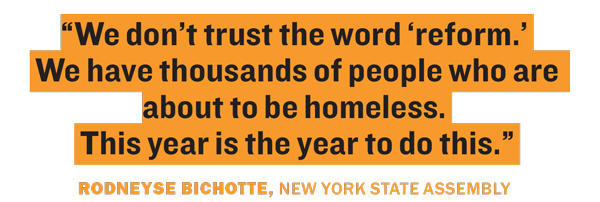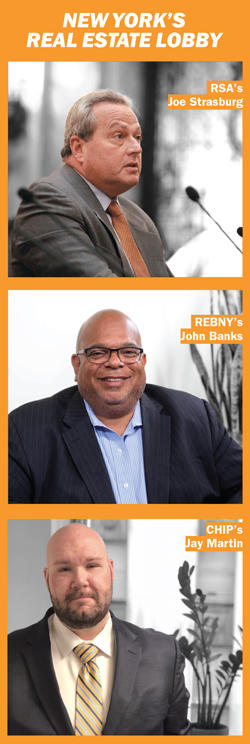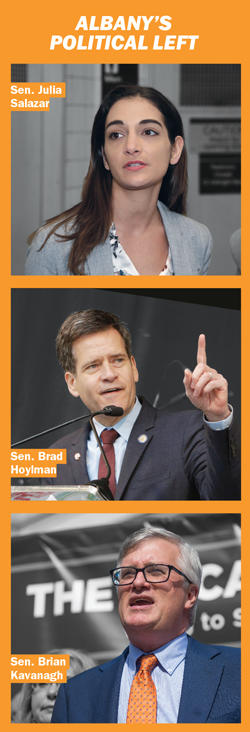Trending
Can real estate lobby the left?
With billions tied to rent reforms on the line, the industry may lose a lot more than elections if it can’t figure out a strategy that goes beyond campaign cash

Cocktail hour at the “Liar’s Ball” — the Real Estate Board of New York’s annual gala — is all about being seen.
Brokers and developers float to and from the open bar, pose for pictures with their peers and public officials, and often sneak out before the main event. At this year’s banquet, though, there were two glaring absences: Gov. Andrew Cuomo and Mayor Bill de Blasio.
One week before the largest real estate event of the year, the mayor pledged to seize property from negligent landlords. Five days later, the governor pushed for an end to vacancy decontrol, a move that would make it harder for landlords to turn workforce housing into homes for the rich. And for the first time in recent memory, both leaders failed to make an appearance at REBNY’s gala this January.
If the real estate industry didn’t take that as a clear sign of New York’s political shift, there are plenty of others. A growing number of city and state officials have vowed to reject money from developers, and the state Legislature recently capped political donations from LLCs at $5,000. At the same time, state programs that landlords have enjoyed for nearly three decades — and which often serve as the basis for their entire business models — could soon disappear.
That all comes in the wake of Albany’s new progressive lineup and the disbanding of the rogue, real estate-friendly Independent Democratic Conference.
And then, of course, there’s Amazon ditching its plans for Long Island City in the face of opposition from local politicians. While the mayor and governor gave their mutual support for that deal, backed by roughly $3 billion in subsidies, the larger movement to the left played a key part in killing it.
“The political environment for real estate is the worst that I’ve seen in 20 years,” said industry lobbyist and attorney Ken Fisher of Cozen O’Connor. “You’ve got elected officials competing to see what new ways of protecting tenants they can come up with. You’ve also got elected officials saying they don’t even want to be known [for receiving] support from the real estate industry — even ones who were happy to take it previously.”
Now, New York developers, market-rate landlords and their advocates face a test far greater than sluggish condo sales or mounting retail vacancies. The city’s real estate industry is grappling with how to best revamp its lobbying efforts before the end of the legislative session in June.

“In New York, it’s probably not an option to say, ‘Bye-bye, Democrats’ and double down on your contributions to Republicans,” said David Birdsell, dean of the Marxe School of Public and International Affairs at Baruch College. “You have to try to find a way to identify issues that Democrats support.”
Feeling the pressure
With no elections to spend millions of dollars on between now and the end of the legislative session in June, New York’s real estate lobby is in dire need of political allies with something it has never had: grassroots.
Even among the industry’s own ranks, there is doubt that lobbying groups like REBNY and the Rent Stabilization Association can achieve that. The two organizations have spent more than $4 million each on state elections over the last five years, and their options are far more limited when it comes to social engagement.
“Quite frankly I don’t know if REBNY and RSA know how to put something like that together,” one veteran real estate lobbyist told The Real Deal on the condition of anonymity. “These are my friends and I respect them a lot, but it’s just not clear to me.”
At risk are loopholes added to New York’s rent stabilization laws over the years that are expected to be reformed or eliminated in 2019. Among them are major capital improvements (MCIs) and individual apartment improvements (IAIs), which allow landlords to charge rent-stabilized tenants more for upgrades.
Freshman Sen. Julia Salazar of Brooklyn, meanwhile, proposed a statewide rent control bill in January that would prevent tenants in almost any market-rate apartment from being evicted for failing to pay “unconscionable” rent hikes.
New York real estate has about three months left in the legislative session to convince state lawmakers the rent is not too high. But Senate Democrats in Albany now hold a majority of 17 seats and are anchored by members based in the five boroughs who have made housing reform the defining theme of their offices.
And REBNY and RSA lost a natural ally when the New York State Association for Affordable Housing declared its support for a slew of rent reforms last fall under pressure from tenant groups that continuously protest its members’ projects. RSA President Joe Strasburg called that alliance with housing activists “duplicitous” in an interview with the Daily News.

Departing Deputy Mayor Alicia Glen told TRD she thinks REBNY will likely support “reasonable changes” to rent regulation. Baruch’s Birdsell echoed that sentiment and said New York real estate will likely need to give some ground on rent regulation and other issues.
“The real estate industry puts money behind saying ‘Don’t force me to build a single unit more of below-market rate housing than I absolutely have to,’” he said. “I think if they want to have a voice moving forward, they are going to have to change that behavior.”
REBNY, which has 17,000 registered members, says it plans to build a “broad-based coalition” to advocate for less regulation in Albany. But according to the trade group’s president, John Banks, there is no plan to include non-REBNY members in that coalition.
Though he declined to talk about how his organization will go about making new alliances, Banks said REBNY had met with half of the new Senate Democrats to discuss policy.
“What we are desperately pleading with people is to understand the unintended consequences of some of the legislation,” he said.
Who will listen?
RSA’s government affairs director, Frank Ricci, was tight-lipped about the group’s political efforts. “Why would I discuss my strategy with you so you could broadcast it to the world?” he told TRD.
But other industry sources pointed to a way forward, including potential alliances with construction labor groups and a push to influence Senate Democrats from districts outside of the city.
Related: The people’s champ — and the industry’s adversary
The Community Housing Improvement Program (CHIP) — a smaller lobbying organization, with 4,000 landlord members — has a more openly ambitious approach: trying to form an alliance with tenants and other community groups not normally seen as landlord-friendly.
“We’re just tiptoeing into this … We’re not natural partners,” said Jay Martin, the group’s new executive director and a former staffer for the eight-member IDC. “We’re reaching out to folks that, as an industry, hasn’t really been done before.”
In a phone interview, Martin outlined a plan to organize residents of rent-stabilized housing against the Democrats’ rent reforms. His organization’s pitch: In an environment of tighter regulations, long-time rental landlords will feel pressured to sell — and the buyers will be the most aggressive investors of the pack, willing to break the rules and jeopardize tenants for a quick profit.
“We’re making the argument that that’s the last course we want to see, and it’s certainly the last course we think the tenants would like to see,” Martin said.
But tenant advocacy groups have their own plans in motion. Every Tuesday, the Upstate-Downstate Housing Alliance organizes bus trips to Albany, where renters from the five boroughs meet with elected officials and their staff to push for policies like statewide rent control and talk about various forms of rent fraud and tenant harassment.
“Real estate knows the landscape has changed,” said tenant activist Mike McKee, who makes the regular trips to the capital. “The power of real estate money has already diminished significantly.”
Sen. Brad Hoylman of Manhattan, who co-sponsored Salazar’s universal rent control bill, said changing the minds of well-organized tenants seems unlikely.

“I think it’s going to be hard to disrupt the current narrative in this session, because there isn’t a lot of evidence that blocking reforms is going to help tenants,” he argued. “So I say good luck with that, and we’ll hopefully look at all the respective positions fairly and make a decision on the merits.”
By the numbers
If attempts to rally tenants around landlord profit margins fall short, another approach lobbying groups said they’ll take is making their case to elected officials with analytics.
“It’s not us merely pushing back on people who may be advocating the opposite of what we’re advocating for,” Banks said. “It’s us being armed with statistics and data.”
RSA tapped the consulting firm Urbanomics to estimate the total investment in the city’s housing stock since vacancy decontrol was first passed in 1994. In that report, the total amount spent on deregulating apartments with construction work was pegged at about $8 billion through the year 2017.
That money, many New York real estate players argue, helps stimulate the city’s economy and would be much less if New York’s rent laws didn’t give landlords an incentive for fixing up rent-regulated properties.
“Both houses of the Legislature have said to REBNY that they understand the need for the private sector to continue to invest in the city’s rental stock,” a source familiar with the trade group’s plans said on the condition of anonymity.

But finding Senate Democrats receptive to that message will be more difficult than ever before. Real estate lost a willing ear in Bronx Sen. Jeff Klein when he lost re-election last fall. And the Republican-allied IDC, which Klein led, collapsed along with him.
“In the past, the process was that the Assembly pushed a certain package of bills and the Senate Republicans — at the behest of the landlords, largely — blocked those bills,” Senate housing committee Chair Brian Kavanagh told TRD.
“Everyone understands this year that it’s going to be different,” he added.
Above and beyond
When New York’s real estate lobby has looked to extend its reach in the past, it has ventured upstate and out to Long Island — something Lee & Associates NYC President Jim Wacht, a REBNY and CHIP member, said lobbyists would be wise to do again.
“You’re never going to convince the people who are dead set against you,” Wacht argued. “So don’t spend a lot of time on it. What you need to do is talk to people who are undecided or don’t really have a horse in the race and see if they will moderate what is proposed.”
Proposals like Salazar’s universal rent control bill — which would apply New York City-style rent stabilization across the whole state — brings upstate politicians into the equation in a way they never have been before.
“It’s a different model of how universal rent control would drastically change the landscape of their districts,” said Martin of CHIP, who is engaging lawmakers outside of the boroughs. “It would be extremely impactful to New York City, but it would be especially detrimental to the suburban districts and the rural districts.”
Though REBNY and RSA have not said targeting upstate legislators is part of their strategy, their campaign contributions historically suggest it is. That includes REBNY’s most recent donations. Of the $27,000 in direct contributions its political action committee made to state senators in the weeks just after the November elections, $21,000 went to three Democrats located outside of the city: James Gaughran of Northport, Anna Kaplan of Great Neck and James Skoufis of Orange Country.
All three of their districts span counties with some rent-regulated apartments, though considerably fewer than any senator from the boroughs. TRD reached out to Kaplan, Gaughran and Skoufis to discuss rent reforms, but none responded.
Asked if RSA would also target Democrats who represent districts outside the city, Ricci laughed.
“I’m not going to get into the specifics of who we’re going to see and when we’re going to go see them,” he said.
Odd alliances
In recent years, REBNY has teamed up with some unlikely partners — the NAACP, Public Housing Communities, the charter school lobby and social welfare groups — on everything from tax policy to city zoning.
And while Banks wouldn’t go into detail on what sort of alliance REBNY is looking to build for rent-regulation issues, some say construction trade groups and labor unions may be real estate’s best shot.
RSA and REBNY have both warned that ending the MCI and IAI provisions would effectively halt major renovations and upgrades to the city’s rental properties. And if that were to happen, many contractors would hypothetically be out of the job.

Lou Coletti, president of the Building Trades Employers’ Association, said his organization has yet to take a stance on MCIs and IAIs but has meetings scheduled with REBNY, where the issue will presumably come up. If construction unions back the real estate industry on these issues, he said, there will be some expectation that property owners opt for union labor more frequently.
“Part of the discussion will involve wanting to be helpful to our clients, but there has to be a discussion about will the loyalty be returned to us,” Coletti said, especially given the growth of nonunion labor in residential development.
Ricci acknowledged that the RSA is looking to small contractors for support, since these groups will be most impacted from changes to rent regulation laws tied to building improvements. “Those contractors and vendors are really going to be affected if owners don’t have the money to do upgrades,” Ricci said.
REBNY declined to comment on any talks between the trade group and the construction unions. And Building and Construction Trades Council President Gary LaBarbera said he hasn’t spoken to the real estate lobby about rent reform.
But REBNY’s role in another coalition may put it at odds with union construction groups.
The Lawsuit Reform Alliance, a nonprofit that advocates against “lawsuit abuse,” has aligned itself with REBNY to repeal parts of New York’s Scaffold Law, which holds property owners liable when construction workers are injured in height-related falls. This has been a recurring issue in recent years, and the effort has come up against strong opposition from the city’s trade unions.
Tom Stebbins, the Alliance’s executive director, said the law drives up insurance premiums, which raises the costs of building affordable housing and schools. The coalition plans to make that pitch to state Democrats. “We have a real opportunity to demonstrate how this will impact issues Democrats care about,” Stebbins said.
Waiting on Cuomo
Most real estate executives worried about their shrinking clout in Albany are banking on the same factor: Gov. Cuomo.
Commercial brokerage owner and former mayoral candidate Paul Massey said being “driven by common sense” and “knowing that our state and our city are hugely dependent on tax revenues directly from real estate” will pull the governor toward the center.
Although Cuomo was pushed to the left by primary opponent Cynthia Nixon, his budget proposal for this year — which includes rent reforms — falls considerably short of the agenda pushed by many of the most vocal Senate Democrats.
It also includes a ransom note: If the Senate does not pass his Rent Regulation Act of 2019 by the end of March, Cuomo will withhold funding from the Division of Homes and Community Renewal, the agency charged with protecting tenants from lawbreaking landlords.
“I think maybe he preferred that we would just focus on [housing reform] in the budget, and that would work in his favor … that on a shorter timeline we would be more likely to capitulate,” Salazar speculated. She told TRD in a phone interview last month that like many of her colleagues she found the governor’s threat of withholding DHCR funding perplexing.
Housing Chair Kavanagh called Cuomo’s budget language “a mistake.”
Many state Democrats also believe the governor’s plan falls short of the reform goals they have set for this year. Cuomo asked for an end to vacancy deregulation, but not an end to the 20 percent rent increases landlords can now get after a vacancy. And he asked for a “limit” on renovation-related rent increases, but not their elimination, which the Senate deputy majority leader, Michael Gianaris, has specifically requested.
“I really don’t understand the strategy of threatening to hurt people to get his way,” Gianaris said. “He’s doing it with the MTA as well. We should all agree we want to help tenants, not threaten to hurt them if someone doesn’t get his way.”
Cuomo’s budget did not touch on other key tenant issues, like universal rent control. And members of his administration have been very careful about how they answer questions regarding the governor’s position on rent regulation.
During a budget hearing last month, Assembly member Rodneyse Bichotte asked DHCR Commissioner RuthAnne Visnauskas if Cuomo supports repealing vacancy decontrol and preferential rent. Visnauskas would only say that the governor advocates reforming the two.
“We don’t trust the word ‘reform,’” Bichotte said. “We have thousands of people who are about to be homeless. This year is the year to do this.”
Representatives for the governor’s office didn’t respond to requests for comment.
Blurring the lines
While New York real estate may fail to form any meaningful alliances tied to rent regulation by June, its lobbying arms will be working much more closely together for the foreseeable future, sources say.
REBNY has taken on a less public role in rent-regulation debates in the past, and Banks acknowledged that RSA tends to be more “aggressive and outspoken” on the subject.
“It’s just that REBNY is a larger, more cautious organization,” he noted. “Some of the responses you see from RSA, you won’t see from REBNY because our membership is such that they want to make sure they can continue operating in the industry without annoying anyone.”
But this year, the “line of distinction” between the two organizations will “blur 99 percent” on issues like vacancy decontrol and MCIs, Banks said.
Whatever stories they team up to tell about life in New York, they will have to resonate more than stories told by their opposition. More than 291,000 New York City apartments have been deregulated since 1994, and the creation of new affordable housing has failed to keep pace with that turnover. Tenant harassment and loose enforcement of rental laws have accelerated that loss in affordability, according to multiple sources.
“I think real estate has to understand the new dynamic in Albany and join the chorus of Assembly members and senators who have been advocating for a system that’s fair,” Hoylman said.
Eddie Small contributed reporting to this article




